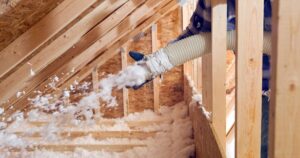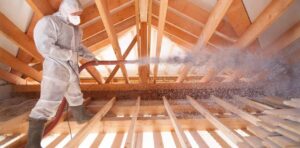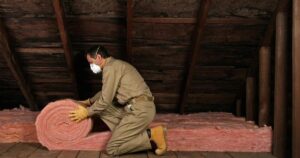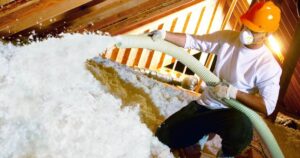Insulating an old house is a crucial step in improving its energy efficiency and overall comfort. To begin, identify areas that need insulation, such as the attic, walls, windows, and doors. Assess the existing insulation and consider options like fiberglass, cellulose, or spray foam. Repair any air leaks and ensure proper ventilation.
Insulation can be added through blown-in techniques or by removing sections and installing new material. For the roof, insulation can be applied between rafters or in the attic space. In older homes, attention to detail and professional assessment are key to effectively insulating the house while preserving its structural integrity.
Why Insulating an Old House is Important
Insulating an old house is crucial for several reasons. Firstly, it enhances energy efficiency, reducing heating and cooling costs. It creates a more comfortable living environment by maintaining consistent temperatures. Proper insulation also helps preserve the structural integrity of the house by preventing moisture build-up, which can lead to mold or rot.
Insulation contributes to reducing the carbon footprint, making the house more eco-friendly and sustainable. By investing in insulating an old house, homeowners can improve the property’s overall value and contribute positively to the environment.
Doors, Windows, and Fireplaces
Doors and windows are common areas for heat loss in older homes. To address this, weather-stripping and caulking can be applied to seal gaps and prevent drafts. Double-glazed or storm windows can also be installed to improve insulation. Fireplaces, while charming, can be a significant source of heat loss. Installing a fireplace insert can help increase efficiency. Alternatively, sealing the fireplace when not in use prevents cold air from entering and warm air from escaping.
The Roof
Insulating the roof of an old house is essential for preventing heat loss. Inadequate insulation in the roof can lead to high energy bills and discomfort. A combination of proper ventilation and insulation between rafters or in the attic space can significantly improve energy efficiency.
The Walls
In an old house, walls can be insulated by adding material to the existing cavity or by using blown-in insulation. Addressing cavity walls involves injecting insulation into the gap between the internal and external walls, while blown-in insulation involves the insertion of loose particles into the wall space. Both methods improve energy efficiency and comfort.
The Floor
Old houses may have floors with or without a cavity. For floors without a cavity, insulating from underneath might be necessary. For floors with a cavity, filling it with appropriate insulation materials helps retain heat and improve overall comfort.
4 Seasons Insulation
Different insulation materials perform differently across seasons. For instance, cellulose and fiberglass insulation both have their advantages. While fiberglass is moisture-resistant, cellulose is eco-friendly and offers better resistance to airflow. Choosing the right insulation material depends on various factors, including climate, cost, and personal preferences.
Is Insulation Flammable? The Definitive Answer
Insulation materials vary in their flammability. While some materials are more fire-resistant, others may be flammable. However, most insulation materials are treated to meet fire safety standards. Understanding the fire resistance properties of insulation is crucial to ensure the safety of the home.
Is Your Home Embracing Sustainable Insulation?
Homeowners are increasingly looking for sustainable insulation options. From recycled materials to natural fibers, sustainable insulation not only reduces environmental impact but also offers efficient thermal performance. Embracing these eco-friendly options aligns with a commitment to environmental responsibility and energy efficiency.
A Guide to Blown-In Insulation
Blown-in insulation is a versatile method of insulating various parts of an old house. It comes in different materials such as cellulose or fiberglass and offers advantages like easy installation and seamless coverage. Understanding the types, advantages, and appearance of blown-in insulation can help homeowners make informed decisions about their insulation needs.
Appearance, Advantages, Types, and More
Blown-in insulation, known for its ease of application and effective coverage, offers homeowners multiple advantages. Its appearance is distinct—a loose-fill material blown into spaces, filling gaps and voids seamlessly. The benefits of this method include its adaptability to different spaces and structures, whether it’s attics, walls, or floors. It can easily cover irregularly shaped areas and around obstructions, providing a more complete insulation solution.
FAQs
How do you insulate between floors in an old house?
Installing acoustic batts in the walls and between floors is the most effective way to improve sound insulation between rooms.
Can I put insulation on my floor?
By reducing the amount of heat loss through the floor, installing floor insulation is a great way to lower energy consumption to ensure lower energy bills.
What is the best thermal flooring?
Ceramic & stone tiles are the best floor materials to use with underfloor heating. They have excellent heat transfer properties and a low profile. They are also very easy to keep clean.
Conclusion
When considering blown-in insulation, homeowners must weigh the types available. Cellulose insulation, made from recycled paper or cardboard, is an eco-friendly option. It’s treated for fire resistance and insect deterrent properties, making it a popular choice for sustainable insulation. On the other hand, fiberglass blown-in insulation, composed of tiny glass fibers, offers high resistance to moisture and doesn’t settle or deteriorate over time.










